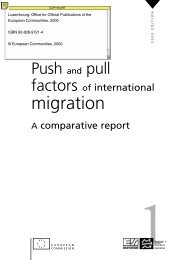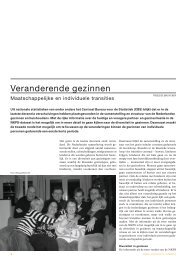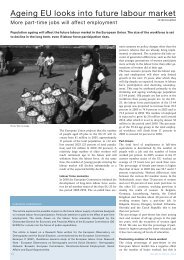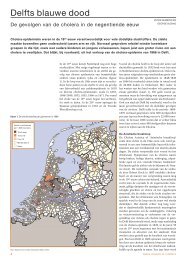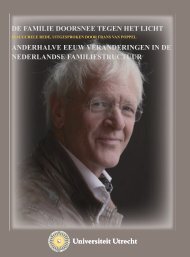Frans van Poppel: a sort of farewell. Liber Amicorum. - NIDI
Frans van Poppel: a sort of farewell. Liber Amicorum. - NIDI
Frans van Poppel: a sort of farewell. Liber Amicorum. - NIDI
- No tags were found...
Create successful ePaper yourself
Turn your PDF publications into a flip-book with our unique Google optimized e-Paper software.
supposed ‘quality-quantity trade-<strong>of</strong>f’ functioned at the level <strong>of</strong> individual couples. Moreover,<strong>Frans</strong>’s analyses <strong>of</strong> nineteenth century demography need to be integrated into new narrativesfor non-specialist audiences. For instance, what do <strong>Frans</strong>’s findings on social mobility,networks and social group differences in mortality and fertility tell us about class formationduring Dutch industrialization? Can we translate <strong>Frans</strong>’s remarkable findings on the lifeexpectancy <strong>of</strong> widows and orphans to a new vision on Dutch welfare? And, finally, how do<strong>Frans</strong>’s finding on strongly internalized religious norms affect our view on the meaning <strong>of</strong>Pillarization?History mattersFor demographers, <strong>Frans</strong>’s legacy is clear: History matters. And it does so in at least threeways. First, <strong>Frans</strong>’s recent work on family composition <strong>of</strong> adolescents in the past 150 yearshas shown the rele<strong>van</strong>ce <strong>of</strong> taking the long view. The current experience <strong>of</strong> growing up inbroken families is mirrored by the many (semi-)orphans in the past (Van Gaalen and Van<strong>Poppel</strong>, 2009). Clearly, the 1950 s do not represent ‘traditional’ Dutch society. If anything,the period 1945-1965 was probably the most ‘untypical’ period in Dutch recent historywith respect to family life. The great challenge <strong>of</strong> historical demography, as demonstratedexemplarily in <strong>Frans</strong>’s work, is to show and understand precisely when demographic behaviorcan be understood in terms <strong>of</strong> continuity, and when it is subject to change. Secondly, theadded value <strong>of</strong> the longitudinal perspective in <strong>Frans</strong>’s demographic analyses is clear; peopleact on past experiences and we cannot understand demographic events in isolation fromearlier ones. Finally, history serves as an ideal laboratory for testing socio-biological aspects<strong>of</strong> demography; e.g. determinants <strong>of</strong> starting, stopping and spacing in a non-contraceptiveenvironment, or the intergenerational transmission <strong>of</strong> behavior (as <strong>Frans</strong> has done on the ageat marriage (Van <strong>Poppel</strong>, Monden and Mandemakers, 2008)).It is to be hoped that historical demographers will take up this challenge and pursue researchalong the lines suggested by <strong>Frans</strong> <strong>van</strong> <strong>Poppel</strong>. Preferably, by expanding into the more distantpast as well. Above all, let’s hope that future generations will be able to work in the true‘<strong>Poppel</strong>ian’ spirit. That is, by tackling the research questions with a balanced mixture <strong>of</strong>qualitative and quantitative content, soundly embedding them in the literature, formulating aclear body <strong>of</strong> testable hypotheses, cautiously interpreting results, and where possible, workingin a truly interdisciplinary setting.ReferencesBengtsson, Tommy and <strong>Frans</strong> <strong>van</strong> <strong>Poppel</strong> (2011), Socio-economic inequalities in death from past topresent: An introduction. Explorations in Economic History, 48(3), pp. 343-356.Gaalen, Ruben <strong>van</strong> and <strong>Frans</strong> <strong>van</strong> <strong>Poppel</strong> (2009), Long-term changes in the living arrangements <strong>of</strong> childrenin the Netherlands. Journal <strong>of</strong> Family Issues, Vol. 30(5), May, pp. 653-669.<strong>Poppel</strong> F. <strong>van</strong> (1992), Religion and health: Catholicism and regional mortality differences in 19 th centuryNetherlands. Social History <strong>of</strong> Medicine, Vol. V, nr. 2, August , pp. 229-253.<strong>Poppel</strong>, <strong>Frans</strong> <strong>van</strong> and Hugo Röling (2003), Physicians and fertility control in the Netherlands. Journal <strong>of</strong>Interdisciplinary History, 34(2), Autumn, pp. 55-18520






